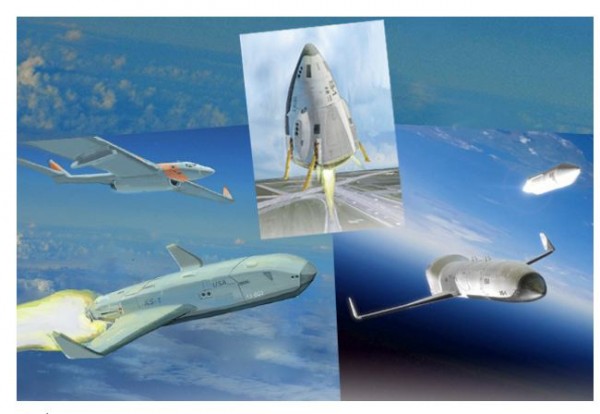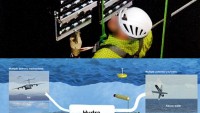Launch Costs for DARPA’s XS-1 Spaceplane to be Cheaper than SpaceX’s Falcon 9
| Arthur Dominic Villasanta | | May 26, 2016 04:33 AM EDT |
(Photo : DARPA) Concepts for DARPA's XS-1 spaceplane
The U.S. Defense Advanced Research Projects Agency (DARPA) intends each flight of its Experimental Spaceplane (XS-1) currently being developed to cost just $5 million, making it over a tenth cheaper than SpaceX.
That compares to $61 million being charged by SpaceX per Falcon 9 flight without the re-usable first stage. With the re-usable first stage, the cost of a Falcon 9 launch should plummet to $43 million.
Like Us on Facebook
Launch costs for United Launch Alliance (ULA), a joint venture between defense giants Boeing and Lockheed Martin that currently has a lock on all U.S. military space launches comes to $225 million per launch. It cost a staggering $450 million to launch a Space Shuttle.
DARPA said the reusable XS-1 will be a robot space plane without a crew. The successor to the U.S. Space Shuttle, the XS-1 when it enters operational service is expected to have a re-usable first stage similar to the Falcon 9 models that have made two successful re-entry landings since April on a drone ship floating in the Atlantic Ocean.
The re-usable first stage will account for most of the launch cost savings. The XS-1 will be capable of deploying a 5,000 lb satellite into low Earth Orbit (LEO). The space taxi will then glide back to Earth to land much like the fabled Space Shuttles.
One of the main goals of the XS-1 program is to have this drone space ship fly 10 times in a 10-day period to prove its aircraft-like access to space and eliminate doubts about the cost-effectiveness and reliability of reusable launch.
The reusable first stage will fly at hypersonic speeds of up to Mach 10 to reach suborbital altitude. One or more expendable upper stages will separate and deploy a satellite into LEO. The reusable first stage then returns to Earth after which it will be prepped for its next flight.
Modular components, durable thermal protection systems and automatic launch, flight and recovery systems should significantly reduce logistical baggage, enabling rapid turnaround between flights.
"During Phase 1 of the XS-1 program, the space industry has evolved rapidly and we intend to take advantage of multiple impressive technological and commercial advances," said Jess Sponable, DARPA program manager.
"We intend to leverage those advances along with our Phase 1 progress to break the cycle of escalating DoD space system launch costs, catalyze lower-cost satellite architectures, and prove that routine and responsive access to space can be achieved at costs an order of magnitude lower than with today's systems."
DARPA has now entered phase two of its space plane project, which means it'll soon award a contract to competing private firms to build a prototype.
Three industry teams are competing: Boeing and Blue Origin (Jeff Bezos' space transport firm); Northrop Grumman allied with plus Virgin Galactic and Masten Space Systems with partner XCOR Aerospace.
This winner of phase two will be awarded the phase three contract to conduct flight tests of the space plane prototype.
TagsDefense Advanced Research Projects Agency, DARPA, Experimental Space Plane, XS-1, SpaceX, Falcon 9
©2015 Chinatopix All rights reserved. Do not reproduce without permission
EDITOR'S PICKS
-

Did the Trump administration just announce plans for a trade war with ‘hostile’ China and Russia?
-

US Senate passes Taiwan travel bill slammed by China
-

As Yan Sihong’s family grieves, here are other Chinese students who went missing abroad. Some have never been found
-

Beijing blasts Western critics who ‘smear China’ with the term sharp power
-

China Envoy Seeks to Defuse Tensions With U.S. as a Trade War Brews
-

Singapore's Deputy PM Provides Bitcoin Vote of Confidence Amid China's Blanket Bans
-

China warns investors over risks in overseas virtual currency trading
-

Chinese government most trustworthy: survey
-

Kashima Antlers On Course For Back-To-Back Titles
MOST POPULAR
LATEST NEWS
Zhou Yongkang: China's Former Security Chief Sentenced to Life in Prison

China's former Chief of the Ministry of Public Security, Zhou Yongkang, has been given a life sentence after he was found guilty of abusing his office, bribery and deliberately ... Full Article
TRENDING STORY

China Pork Prices Expected to Stabilize As The Supplies Recover

Elephone P9000 Smartphone is now on Sale on Amazon India

There's a Big Chance Cliffhangers Won't Still Be Resolved When Grey's Anatomy Season 13 Returns

Supreme Court Ruled on Samsung vs Apple Dispute for Patent Infringement

Microsoft Surface Pro 5 Rumors and Release Date: What is the Latest?














